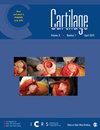Magnetic Resonance Observation of Cartilage Repair Tissue (MOCART) Scores > 55 at 6 Months Postoperative Predict Ability to Achieve Patient Acceptable Symptomatic State at Minimum 1 Year Postoperative Following Autologous Chondrocyte Implantation for Grade IV Chondral Defects About the Patellofemoral Joint
IF 2.7
4区 医学
Q1 ORTHOPEDICS
引用次数: 0
Abstract
PurposeThe primary aim is to evaluate the relationship between MOCART scores and patient satisfaction, as evaluated by achievement of (1) the Patient Acceptable Symptomatic State (PASS) and (2) the minimal clinically important difference (MCID) for Knee Injury and Osteoarthritis Score Quality of Life (KOOS QoL), for patients undergoing autologous chondrocyte implantation (ACI) for focal Grade IV patellofemoral chondral defects. The secondary aim is to determine the threshold MOCART score which predicts the ability to meet the PASS and the MCID for KOOS QoL.MethodsPatients undergoing ACI for grade IV patellofemoral chondral defects by a single surgeon from 2017 to 2020 were identified by search of the EMR. To determine PASS status, patients were asked, “Do you consider your current level of symptoms to be acceptable?” KOOS QoL scores were also collected. Patients with 6-month postoperative knee MRI, PASS scores, and minimum 2-year follow-up data were included. Paired t tests and Wilcoxon Rank-Sum tests were used to evaluate the relationship between MOCART scores and (1) PASS achievement and (2) achievement of the MCID for KOOS QoL (12.8).ResultsThirty-four patients were included, with a median age of 35.1 years [IQR: 24.6, 37.1], and BMI of 24.0 kg/m软骨修复组织磁共振观察(MOCART)术后 6 个月评分 > 55 分可预测自体软骨细胞植入治疗 IV 级髌股关节软骨缺损术后至少 1 年达到患者可接受症状状态的能力
目的主要目的是评估MOCART评分与患者满意度之间的关系,患者满意度的评估指标包括:(1)患者可接受症状状态(PASS)和(2)膝关节损伤和骨关节炎生活质量评分(KOOS QoL)的最小临床重要差异(MCID)。次要目的是确定预测KOOS QoL达到PASS和MCID能力的阈值MOCART评分。方法通过搜索EMR确定2017年至2020年期间由单个外科医生接受ACI治疗IV级髌骨软骨缺损的患者。为确定PASS状态,患者被问到:"您认为您目前的症状程度可以接受吗?"同时还收集了 KOOS QoL 评分。患者术后 6 个月的膝关节 MRI、PASS 评分和至少 2 年的随访数据均包括在内。采用配对t检验和Wilcoxon秩和检验来评估MOCART评分与(1)PASS得分和(2)KOOS QoL MCID (12.8)得分之间的关系。结果共纳入34名患者,中位年龄为35.1岁[IQR:24.6, 37.1],BMI为24.0 kg/m2 [IQR: 21.5, 28.1]。术后磁共振成像的中位时间为 6.7 个月 [IQR: 5.8, 7.9],平均随访时间为 3.7 ± 1.2 年。25名患者(74%)获得了PASS,18名患者(27名术后获得KOOS QoL评分的患者中,67%)的KOOS QoL达到了MCID。达到 PASS 的患者的平均 MOCART 得分(61.8 ± 16.0)高于未达到 PASS 的患者(45.0 ± 12.8,P=0.011),而达到 KOOS QoL MCID 的患者的 MOCART 得分并不比未达到 MCID 的患者高(61.9 ± 18.3 对 53.3 ± 17.1,P=0.25)。年龄、性别、病变大小和病变位置与达到 KOOS QoL PASS 或 MCID 的能力之间没有关系(P>0.05)。结论MOCART评分越高,髌骨骨关节置换术后获得PASS的可能性越大。此外,MOCART评分> 55可预测髌骨关节置换术后达到PASS的能力和KOOS QoL的MCID。
本文章由计算机程序翻译,如有差异,请以英文原文为准。
求助全文
约1分钟内获得全文
求助全文
来源期刊

CARTILAGE
ORTHOPEDICS-
CiteScore
6.90
自引率
7.10%
发文量
80
期刊介绍:
CARTILAGE publishes articles related to the musculoskeletal system with particular attention to cartilage repair, development, function, degeneration, transplantation, and rehabilitation. The journal is a forum for the exchange of ideas for the many types of researchers and clinicians involved in cartilage biology and repair. A primary objective of CARTILAGE is to foster the cross-fertilization of the findings between clinical and basic sciences throughout the various disciplines involved in cartilage repair.
The journal publishes full length original manuscripts on all types of cartilage including articular, nasal, auricular, tracheal/bronchial, and intervertebral disc fibrocartilage. Manuscripts on clinical and laboratory research are welcome. Review articles, editorials, and letters are also encouraged. The ICRS envisages CARTILAGE as a forum for the exchange of knowledge among clinicians, scientists, patients, and researchers.
The International Cartilage Repair Society (ICRS) is dedicated to promotion, encouragement, and distribution of fundamental and applied research of cartilage in order to permit a better knowledge of function and dysfunction of articular cartilage and its repair.
 求助内容:
求助内容: 应助结果提醒方式:
应助结果提醒方式:


